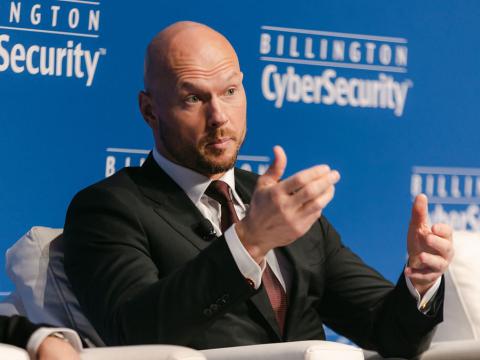Networx Set to Boost Federal Networks
Contracts will give agencies the opportunity to upgrade to the latest technologies. 
Booz Allen Hamilton Networx Program transition team members Stacey Donald (l), associate; John Feeney (c), principal; and Jason Williamson, senior associate, review a network transition plan. The company has been assisting the U.S. General Services Administration (GSA) to develop transition plans for the move from FTS2001 to the Networx Universal and Networx Enterprise contracts.
Back in 1988 when the average price of gasoline was $1.12 a gallon, the
The Networx program comprises two separate yet similar acquisitions. Networx Universal is designed to meet the needs of agencies through one large supplier that offers comprehensive services and national and international coverage. Vendors or company teams vying for the contract had to show that they could provide a majority of the capabilities called for in the request for proposal. The second acquisition, Networx Enterprise, will offer government agencies access to a wider range of services and service providers. Because the Networx Enterprise contract’s list of mandatory offerings is shorter, companies that specialize in niche or emerging technologies could fulfill the contract requirements.
Although many of the same services can be found on both contracts, they will expand the General Services Administration’s (GSA’s) portfolio of offerings from approximately 34 core services available today to roughly 50 core services on each contract. The GSA plans to award the Networx Universal contract in July and the Networx Enterprise contract in September.
John C. Johnson, assistant commissioner for service development and service delivery, FTS, GSA, explains that the Networx program reflects the changes that have taken place in technology, usage, organizations and pricing. In early 2001, for example, the GSA’s portfolio consisted largely of providing voice telephony capabilities, which accounted for nearly 84 percent of the administration’s business volume. Today, voice usage accounts for only about 30 percent of the total volume. “We’ve expanded into the IP [Internet protocol] area—crafting custom-designed solutions—and in security services and other services such as Web hosting. While voice has grown at an average rate of about 6 percent a year, as part of the overall portfolio of services we offer, it’s shrunk, which indicates that we’re growing tremendously in other areas,” he says. This growth is evident in the administration’s overall increase in volume, which grew by 26 percent last year, he adds.
The increase in volume is significant in light of how prices have decreased over the years. For instance, in 1999 the average cost for a T-1 circuit was about $1,750; today it is approximately $420. “That isn’t to say that the price of T-1s in other areas outside of FTS hasn’t been reduced too. As we build up our bandwidth in terms of an infrastructure, obviously cost per bit is going to go down. But the program has really helped establish a benchmark for low pricing in the federal community,” Johnson says.
The facts speak for themselves. The GSA estimates that in 2005 it saved federal agencies approximately $600 million in terms of the best commercial pricing available for services. Its prices are about 40 percent below commercial prices.
In anticipation of the FTS2001 contracts’ expiring, the GSA examined trend data about the evolution of both its offerings portfolio and technology. The contract with Sprint concludes in December 2006; MCI, in January 2007. The GSA noted the tremendous increase in the area of IP-related capabilities as well as changes in the service provider landscape as mergers and acquisitions continued and new companies opened their doors with new services.
To ensure that the FTS2001 replacement could benefit from these changes, the GSA developed an agile strategy that allows it to continue to provide the best value to its customers and at the same time to take advantage of the changes in the marketplace. Together with the Interagency Management Council (IMC), four IMC working groups and federal agency representatives, GSA personnel set eight goals: service continuity, highly competitive prices, high-quality service, full-service capability, alternative sources, operations support, transition assistance and support, and performance-based contracts.
The Networx Universal contract focuses on providing service continuity as well as competitive prices and full service. The Networx Enterprise contract requires companies to offer a core set of IP-oriented or wireless services; however, it gives new companies, which may not be equipped to offer a full range of services, the opportunity to break into the government marketplace because it lists far fewer mandatory services. Johnson says the GSA anticipates that the business volume of the Networx contracts will be approximately $20 billion over a 10-year period.
“In Networx, what we’re doing is evolving toward converged services—the evolution of the legacy environment toward the integrated IP environment with embedded security and applications riding over that IP structure. Those will be surrounded by performance-based technical specifications and service-level agreements and the opportunity for customers to be credited if the service-level agreements are not adhered to in terms of performance. It’s a focus on evolving technology, an ability to provide a plethora of services to our customers and a different management approach in terms of how we manage the performance of these contracts with the ability to credit customers if the performance isn’t met,” Johnson explains.
The GSA also is embedding security within the Networx program and has identified different security levels that customers can purchase. Various types of products will be available to provide information protection—from sensitive to highly classified.
Experience gleaned from the FTS 2000 to FTS2001 move emphasized the importance of change management, so the GSA has been working on its transition planning throughout Networx program contract development. The switch from FTS 2000 to FTS2001 was marred by a number of delays that occurred for a variety of reasons. According to the U.S. Government Accountability Office, FTS2001 contractors did not provide the GSA with the management data necessary to measure and manage the transition. The GSA and long-distance contractors could not add transition-critical services to the FTS2001 contract, and customer agencies were slow to place orders for transition services in part because of Year 2000 (Y2K) computing concerns. In addition, problems with staffing shortages and turnover as well as with billing and procedures hampered FTS2001 contractors’ efforts to support agencies’ transition activities.
To get ahead of these issues, the GSA began transition planning more than a year ago, Johnson says. From the lessons learned in the FTS 2000 to FTS2001 transition, the GSA recognized that while each agency approaches a transition in somewhat different ways, common problems occur. To address these, the administration wanted to create an environment where lessons and corrective actions could be shared.
“We learned that upfront planning is absolutely critical to our success, and we need to develop repeatable processes and procedures and share those with everyone so that we can move the government forward in unison. It was unfortunate that we didn’t do as much planning as we could have the last time, and this time we’ve really taken it seriously to make sure that everyone is well informed,” Johnson offers.
The previous transition experience also taught the GSA that it is absolutely essential that agencies have a handle on their inventory. This information will help the GSA ensure it can provide continuity of service and concurrently allow agencies to avail themselves of new technologies and services that improve their mission performance, he notes.
Johnson says he also put a program manager in charge of leading the transition effort and that responsibilities for the move have been assigned. “We’ve taken a look at the contract to make sure the proper requirements are in there to ensure that the contract itself doesn’t encumber our transition success. An example of that is, in the transition from FTS 2000 to FTS2001, customers were concerned that they couldn’t be billed properly for the services that they were ordering, and many of them just stopped until that billing issue was resolved with the service provider. This time, there’s been a lot of discussion about some of our operational requirements in the Networx contract. This time we require that the service providers demonstrate that they can properly bill the customer before transition occurs. That’s another example of a lesson learned that we’ve applied and we’ve embedded within Networx,” he states.
To assist in the transition, the GSA contracted with Booz Allen Hamilton Incorporated,
 |
| Engineers at the MCI Network Operations Center monitor and manage the company’s OC-192 global Internet protocol network. MCI is one of the companies that responded to the GSA’s Networx Program request for proposal. |
The way the contracts are structured enables organizations that are satisfied with their current service provider and services to move to the new contracts in a like-for-like transition, Feeney explains. However, even to come to this conclusion, agencies will need to evaluate all of the Networx contract winners and to determine the best fiscal decision to meet strategic goals. “That’s something they haven’t done in the past and haven’t needed to do in the past,” he notes.
Organizations also will need to decide which Networx program capabilities they need and which they can live without. The direction they go will be based in part on their strategic plans and will influence how they perceive the Networx program. “This decision may look like they need to pull resources away from other places and invest in [the program]. Or, to the chief financial officer, it might look like a great opportunity to invest in an infrastructure project that’s going to have a phenomenal return on investment and to streamline his process in terms of building the enterprise network that they’ve been talking about for 5 or 6 years,” Feeney states.
Inventory is another issue agencies will have to address. The transition will require them to assess their current technical capabilities and to determine which ones it makes sense for them to replace in a like-to-like transition or whether they should move to newer capabilities.
“The data collection effort, and understanding that data, is a big challenge, particularly in organizations that are frequently staffed for steady-state operations. There are not seven or eight people waiting for the next transition,” Feeney says. “Figuring out how to get staffed up, working through these issues and having the appropriate amount of resources available while working the ongoing day-to-day operational activities is a challenge. If done properly, this can be a huge benefit to the telecommunications community. Done last-minute and under budget, it could be a very painful process that leads to disruption of government organizations, not just the telecommunications industry.”
Despite these challenging issues, Feeney says the Networx program offers a multitude of benefits to federal agencies. Most of his clients are telecommunications managers who can view the Networx transition as an opportunity to realign their networks or to upgrade their networks to the latest technology. “If you’re going to have to go through a transition anyway, why not transition to the latest and greatest technology? A certain percentage of my clients are going to take a look at this and say this is a great opportunity to put in that new architecture that they’ve been studying for a while,” he notes.
The GSA is now deep into the evaluation stage of the requests for proposals, but Johnson continues to plan for the future. His initiative, called BOSS, for Business and Operations Support System, aims to examine how the GSA will bill customers in the years to come. “Is the approach that we’re using today really optimal in terms of providing them with business intelligence to make informed decisions? As you would anticipate, if we’re providing that much service to our customers via our contracts, we’re collecting and disseminating a great amount of data. We want to make sure that that data is available to the various stakeholders—GSA, our customers and perhaps industry to some degree—to make informed decisions,” he states.
New Contracts Will Influence Business Practices Federal agencies aren’t the only organizations that will experience change as the U.S. General Services Administration transitions to the Networx program. The challenges and opportunities that the program presents will extend into the commercial sector as well. MCI, The benefits the Networx contracts bring to companies are significant; however, firms will need to change the way they work with customers, Forbes notes. When company representatives meet with agencies, they will have to understand clients’ business problems then determine how products can be integrated to solve them. “It allows us, in a single contract vehicle, the ability to bring all those bits and pieces together as a services-based integrator. So, from a corporate point of view, it allows me to deal much more at a knowledge-based level. Rather than asking them, ‘How many telephone lines, or how many IP [Internet protocol] ports, do you need?’ I can now talk to them about a broader range of requirements. I can ask, ‘What do you need in Billing structures are another driver in the cost scenarios, Forbes points out. For companies, traditional billing processes are extremely expensive. The flexibility of the Networx contracts moves billing in the direction of the consumer marketplace methods where customers pay for a package rather than individual telephone calls, for example. Flat-rate billing will reduce the amount of staff and time required to verify charges. From a government standpoint, personnel who spend hours scrutinizing numerous lines of call charges will become what Forbes calls “knowledge workers” because the telecommunications companies deliver this data to them. Industry will face challenges as well, he admits. Companies will have to keep up with customer requirements—requirements that continue to push technology in significant ways, particularly in the area of converged networking and converged networking services, Forbes says. Other challenges include integrating wireless into fixed wireline networks and providing the security that government agencies need in the wireless realm. Addressing these issues will require significant investments to keep up with the technology, he adds. Despite these challenges and the possibility of increased com petition, Forbes believes the Networx program will not only be good for government agencies and industry but will be good for technology as well. “The technology changes we’re going to see are going to continue at a good pace. Networx reinforces that pace and us to keep the investment stream, from a technical standpoint, going in the right direction,” he says. |
Web Resources
Networx Program: www.gsa.gov/Portal/gsa/ep/contentView.do?P=TOS3&contentId=16100&contentType=GSA_OVERVIEW
General Services Administration: www.gsa.gov
Booz Allen Hamilton Incorporated: www.bah.com



